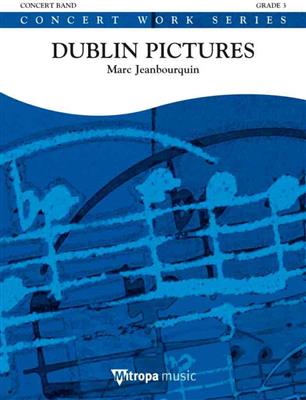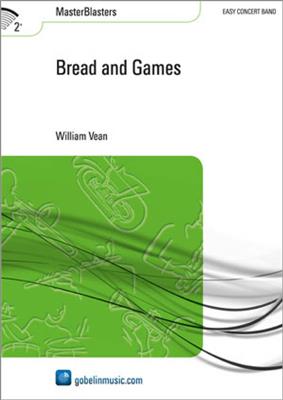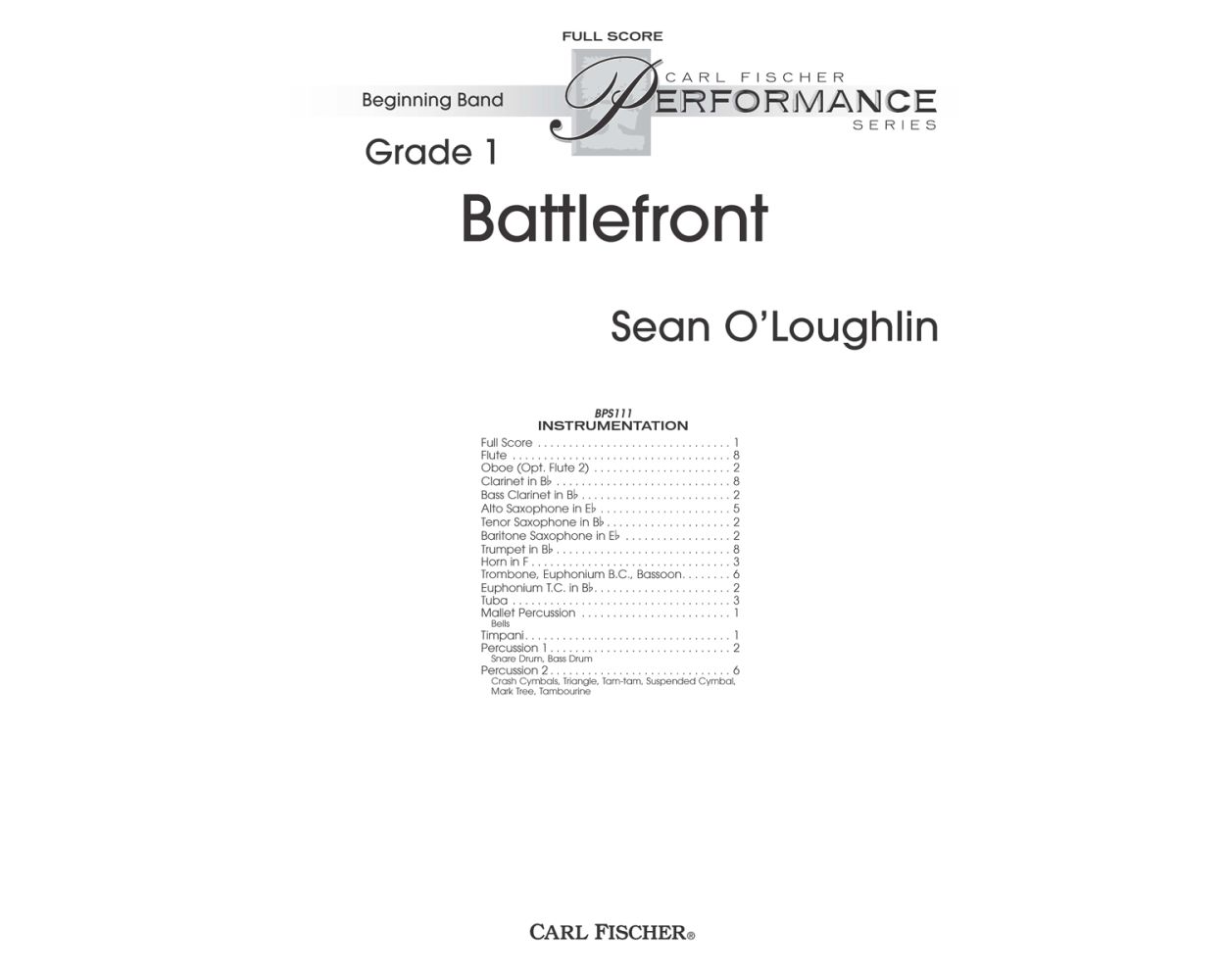Results
-
£61.95
Battlefront - Sean O'Laughlin
Battlefront is a cinematic composition for the developing concert band. The music is bold and rhythmic throughout but also contains contrasting lyrical sections that allow for valuable teaching moments. The prominent use of the lower voices in the melodic passages is a perfect opportunity for them to take the lead while showing the high voices how to accompany, strengthening your ensemble's unity and awareness.
Estimated dispatch 7-14 working days
-
 £42.50
£42.50Gold Medal March - Paul Murtha
In this piece for second-year players, Paul Murtha masterfully adapts the traditional military march form for young musicians. The first strain is carried by trumpets and upper woodwinds, while the low brass take the lead on thesecond strain. After a brief percussion break, the legato trio melody features the woodwind section. A call and response breakstrain is followed by the full band on the rousing finish. Keep the march alive with this marvelouspiece! Dur: 2:50
Estimated dispatch 7-14 working days
-
£45.95
Equus - Erik Morales
Equus, Latin for "horse," takes us on a thrilling ride on one of these magnificent animals. Wood blocks help create the sound of the horse as the ensemble comes along for the ride. A serene section at the same tempo almost seems to slow the ride down, so listeners can take the time to appreciate the scenery around them. The opening material then returns as the piece comes to a strong conclusion.
Estimated dispatch 7-14 working days
-
 £57.50
£57.50A Thousand Heroes - James Curnow
James Curnow's impressive compositional style resounds in this tribute to the heroic deeds of so many citizens of Sioux City, Iowa upon the tragic crash of United Airlines Flight 232 in 1989. This will be the landmark piece of theyear for your solid grade 3 band. A bold fanfare opening soon warms with the stately clarinets. Subtle reflection on the fanfare statement permeates the development of the piece, keeping the city's heroism and self-sacrifice inmind as the piece traverses its many moods. James Curnow's skillful orchestration allows the director endless opportunities to take the band's level of performance to higher levels.
Estimated dispatch 7-14 working days
-
 £244.99
£244.99Brabantia Aeterna - Jan Bosveld
In 2006 Brabant will be celebrating it's 900th anniversary. On May 13th 1106 the count Van Leuven was appointed duke of Brabant. This was the birth of the duchy of Brabant. For centuries this duchy, situated in the heart of the Netherlands, was the primary of the seventeen provinces in the Lowlands. Brabant formed with it's capital cities Brussels, Leuven, Antwerp and 's-Hertogenbosch the focal point for politics, culture and economy. The revolution against Spain (1566-1648) caused a fracture between the North and South. The old duchy was divided into a Dutch and Belgian part. Even though each had their own historical background, the bond forged in the past was partially keptalive. To this day we still have a duke of Brabant. Brabantia Aeterna takes you on a musical journey through 900 years of Brabant history. A fascinating journey portraying war and peace, love and grief, prosperity and adversity, development and deterioration. Listen to how monks chanted, bells tolled and churches were built. Or take the thirteenth and fourteenth centuries with their bustling markets, builders of cities or the bleating of countless sheep across the heather. The plague, tribulations, soldiers and political bickering in the following centuries. Hear how the industrialisation of the nineteenth and twentieth centuries provided prosperity for the region and how to this day the following saying still applies: 'the road to Brabant leads to a warmer world' Brabantia Aeterna was commissioned by the Brabantse Bond van Muziekverenigingen (Brabant Music Society) in honour of its fifth anniversary.
Estimated dispatch 7-14 working days
-
 £228.70
£228.70Konsertouverture - Viktor Widqvist
This piece was composed in 1937 in the composer's later part of life. Here, Widqvist shows his broad competence as a composer by using both classic marching and late-romantic thematic elements with exciting harmonic twists. In addition, you can find a perfect fugue where the composer shows that he masters this advanced composition technique. One can imagine that Widqvist wanted to show off his entire repertoire of knowledge to take the lead in the unspoken competition with colleague and friend Sam Rydberg. Rydberg had several years earlier composed a concert overture with a similar form. However, this piece is simpler in its design and lacks the technical brilliance that Widqvist shows in his contrapuntal treatment and harmonious diversity.The concert overture was re-orchestrated in 1939 by the composer for symphony orchestra, and it is this version and the original score for a large military orchestra that form the basis for this edition. My aim has been to keep all of Widqvist's original intentions, but still make use of all the possibilities of the modern symphonic wind orchestra. The composer's own arrangements for symphony orchestra have been of great help in this work.- Niclas Blixt -
Estimated dispatch 7-14 working days
-
 £134.99
£134.99Dublin Pictures - Marc Jeanbourquin
Ireland is a multi-faceted country that has developed a popular and distinctive musical culture. The first movement of Dublin Pictures reflects Irish festivals where there is dancing and traditional beer flowing. More tranquil in its feel, the second movement illustrates the landscape that can be seen from the Ha'penny Bridge, a bridge that crosses the River Liffey in Dublin. This movement highlights the wide range of the orchestra's sound colours as the musicians' voices combine with the wind and percussion to accompany the soloist. The lively and joyful rhythms of the last movement take the listener to Temple Bar, the famous tourist quarter of the city, well knownfor its vibrant nightlife. The music's energy and virtuosic motifs are in contrast to the previous movement and provide a spirited and festive finale.Marc Jeanbourquin wrote this piece in three movements for Azimuts Brass in 2011. He then arranged it for Concert, Fanfare or Brass Band
Estimated dispatch 7-14 working days
-
£69.99
Specto Leviosa - Stephen Bulla
Move over, Harry! Your band members are the sorcerers this time as they take the audience to mystical realms. A captivating spell is cast as the music conjures up the drama and mystery of ancient magic. The foreboding opening will appeal to the young musician's sense of adventure, and as the piece progresses every listener will be mesmerized by the unfolding prestidigitation. The runes are cast! There is no escape! If you don't choose this piece for your concert beware - you may turn into a frog!Abracadabra! Poof!
Estimated dispatch 7-14 working days
-
 £84.99
£84.99Bread and Games - William Vean
'Panem et Circenses', Bread and Games were essential for keeping the citizens of ancient Rome in check. While the bread was meant for the poorest among the Romans, the Games were Popular Pastime Number One for everybody.There were different kinds of games, such as chariot races (especially popular with female spectators), or wild-beast fights, where lions, tigers, bulls or bears were set on one another or even on human beings. Most popular, however, were the Gladiator fights. In 'Bread and Games' William Vean depicts one of the many fights in the antique Colosseum. 1. Entrance of the Gladiators: By powerful bugle-calls the attention of the peoplewas asked for, after which the Gladiators entered the Arena at the sound of heroic marching-music.2.Swordfight: We can hear that the fights were not mere child's play in this part.On the contrary, they were a matter of life and death and were fought accordingly.3.Mercy of the Emperor: Sometimes a wounded gladiator could be fortunate, depending on the mercy of the audience. Waving one's handkerchief meant mercy, a turned-down thumb meant no pardon. The Emperor had the right to take the final decision, but he usually complied with the wish of the majority of the public. 4.Lap of Honour: Gladiators were mainly selected among slaves, convicted criminals, or prisoners of war. Consequently, winning was very important, as it would mean fame, honour and sometimes even wealth. A lap of honour, therefore, was the winner's due reward.
Estimated dispatch 7-14 working days
-
 £41.00
£41.00Battlefront
Battlefront is a cinematic composition for the developing concert band. The music is bold and rhythmic throughout but also contains contrasting lyrical sections that allow for valuable teaching moments. The prominent use of the lower voices in the melodic passages is a perfect opportunity for them to take the lead while showing the high voices how to accompany, strengthening your ensemble's unity and awareness.
Estimated dispatch 12-14 working days
